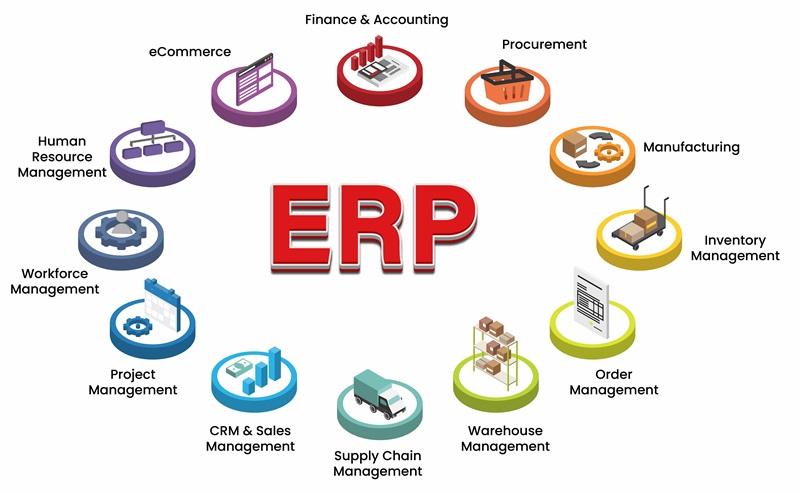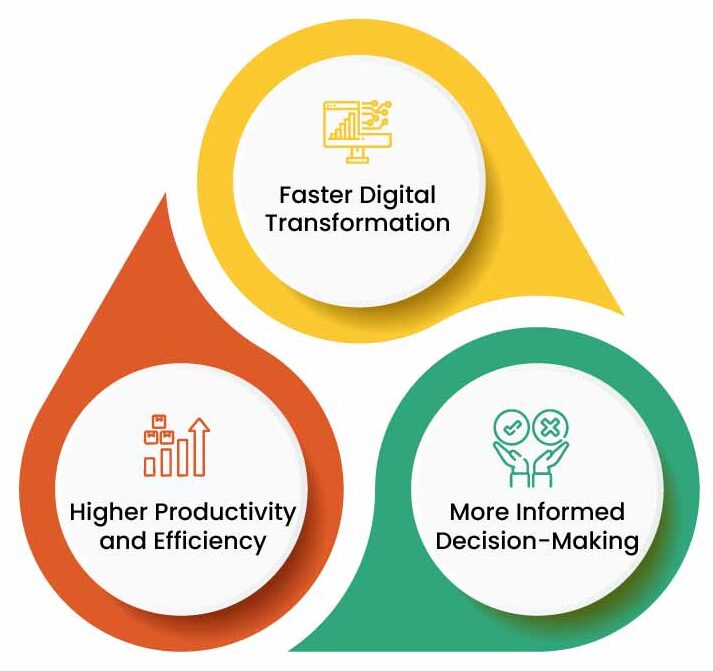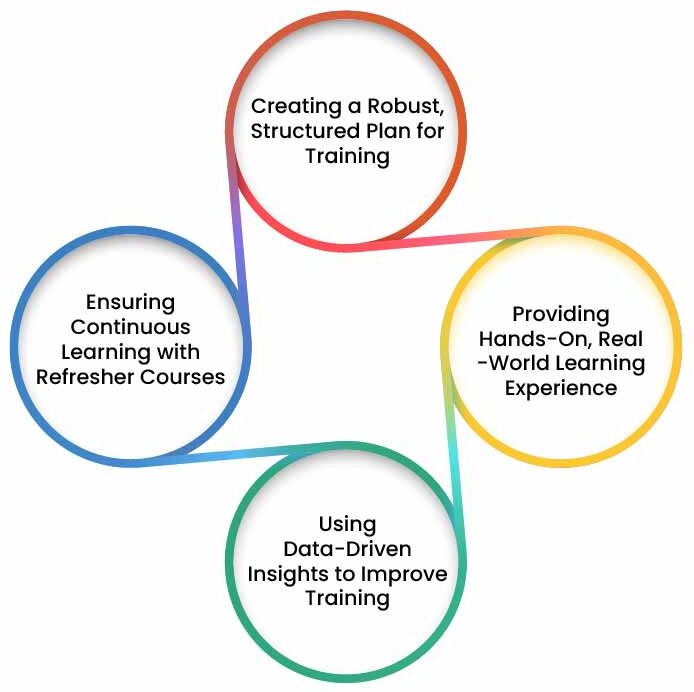Introduction

Digital transformation in a company does not involve just one department or operational process; it needs to be done across the business. According to Sage Software, over 85% of companies are investing significantly in digital transformation initiatives in an attempt to automate more and more of their processes.
What you also notice is how a lot of these companies are integrating digital ERP solutions into not just core business operations but also allied processes that can be managed using software targeted for them. For example, 54% are using ERP software to improve analytics and reporting, 41% blended ERP and CRM usage for better client service, 26% used it in their marketing activities, and so on.
This highlights just how versatile ERP systems are and how much they contribute not just to primary business dealings but also to auxiliary ones. Now, when talking about ERP software, the solution that deserves first mention is SAP. SAP is the top choice and one of the oldest options for business ERP needs across the world. It is an application suite that takes care of nearly every process and operation possible in an organization. As a result, SAP adoption will encompass digitization for most of your business. And when you implement SAP, you know that SAP training for digital transformation becomes essential. That is why Assima is here with the most advanced SAP training solution ever to streamline your digital transformation endeavors.
Interested in what we have to offer for enterprise SAP training? Check out Assima’s SAP training solutions now!
The Role of SAP in Digital Transformation
SAP is an application suite that helps businesses run their processes smoothly by centralizing their data and processes on a single software system. It allows you to manage all core departments like finance, production, procurement, HR, supply chain, materials management, marketing, sales, and customer experience.
In fact, according to the SAP website,
“SAP was one of the first companies to develop standard software for business solutions and continues to offer industry-leading ERP solutions.”
Having pioneered digital enterprise resource management, it has always been ahead of its time in finding ways to help businesses, big and small. Digital transformation with SAP will ensure a smooth and streamlined transition free of the hassle of implementing discrete solutions of each process and then crafting strategies to unify them somehow.
Due to various factors like the sheer number of tools and solutions in the SAP suite, the complex and feature-heavy nature of the solution, the continuing presence of some of its legacy elements, proprietary coding language, and other factors, SAP has a pretty steep learning curve. Hence, it is not feasible to provide just basic SAP training for employees. Unless tailored training is provided to teach the user every aspect of the application they need to know to perform their daily tasks without hiccups, there is little hope for success in enterprise SAP adoption. Results-driven, optimized training is the only way to optimize the outcome of SAP deployment.
Common SAP Adoption Challenges in Enterprise
An organization often must deal with multiple SAP implementation challenges, which results in overshooting the deployment budget and schedule, poor adoption rate, and underwhelming ROI. Besides the general challenges of digital transformation, there are a few roadblocks unique to SAP adoption that you must account for too:
Steep Learning Curve
As we mentioned before, SAP is not an easy software application suite to learn. As a result, learners often drop from the training program or fail to complete it. This becomes a major hurdle in the path of SAP adoption in enterprises and leads to a failed implementation project.
Resistance to Change
User resistance is common in most digital adoption projects but is especially pronounced when dealing with SAP. Because it is difficult to learn, people believe that it is just not worth learning or using at all. This results in undue resistance to SAP adoption.
Lack of User Confidence
Even if you succeed in getting your employees to train in and start using SAP, it won’t necessarily amount to enthusiastic adoption. Users might still have doubts regarding their skills and feel a lack of confidence, thus slowing them down and affecting their performance.
High Error Rates
If your organization fails to train your employees properly, the rate of occurrence of errors in the use of SAP will be high. This will result in a lot of downtime, system glitches, and other problems that would take a lot of time to fix and adversely impact productivity.
Poor Choice of DAP
When it comes to SAP training for digital transformation, the choice of a digital adoption platform plays a major role in the success of the implementation. Utilizing a DAP not suitable for your particular use case would result in poor adoption and skill-building.
Read more about the common challenges in SAP adoption and how to overcome them in detail in this blog.
How Training Supports a Smooth SAP Implementation
SAP ERP system training can impart a lot of benefits to your business operations. It can make the difference between a successful and a failed SAP user adoption project.

Reduces Helpdesk Calls and Tickets
A frequent observation during any software implementation, especially SAP, is the increase in the number of calls and tickets to the helpdesk. This overloads helpdesk staff and takes them away from other emergencies. Training reduces the number of helpdesk incidents greatly.
Ensures Consistency in System Usage
Training helps homogenize the use of SAP. Without training, the most common scenario would be that employees with prior knowledge in SAP would be the only ones using it to its full potential, monopolizing the utilization of a highly useful digital solution.
Minimizes Costly Mistakes in SAP Usage
Practice makes perfect. The more you practice using SAP in training, the lower the chances of you making mistakes in the live environment. This increases the quality of work output and reduces downtime due to human errors introduced into the system.
Reduces Onboarding Time for Employees
SAP, being a difficult application to learn, would, without training, require a long time to learn and master. This increases the onboarding time of employees. Providing suitable training reduces the onboarding time and makes SAP deployment quicker.
Benefits of SAP Training for Business Growth
When L&D is done right, you will notice significant SAP training benefits in your company. This includes:
Faster Digital Transformation
When you provide SAP training for digital transformation in a targeted manner, you get faster, smoother, and better digital transformation results. The chance of failure decreases, and your workforce accepts the changes more gracefully.
More Informed Decision-Making
When people know how to operate SAP and read and analyze the data on it accurately, they develop a clearer understanding of the status of business operations and can make more informed, data-driven decisions that will positively impact the organization.

Higher Productivity and Efficiency
Business process optimization with SAP is only possible when sufficient training is provided. With proper training, there will be an assured improvement in the performance of the employees, resulting in an increase in the productivity and efficiency of the company.
Why Assima Train is the Best SAP Training Solution
SAP digital transformation can be optimized to the highest degree easily, only with Assima. Here’s how Assima’s innovative features and solutions are targeted to ensure a streamlined SAP training and implementation:
Interactive, Real-Time Training Simulations
Assima Train uses 4X patented cloning technology to create hyper-realistic simulations that are highly interactive and perfectly replicate the live system. This ensures an immersive, hands-on learning experience that improves knowledge retention and recall.
No Risk of Training in a Live SAP Environment
By using simulations, you can ensure the same benefits of live training but without any of the risks. You do not have to worry about errors messing up the live system or learners being too scared or doubtful to take the necessary action or provide the necessary input.
Role-Based Customizability of Lessons
Assima Train clones can be easily edited to create different versions based on the varying responsibilities of the workforce you are training. You can also create multiple datasets from one source. On the other hand, Assima In-App Search provides information based on a person’s role in the live application.
Extensive Localization Capabilities
Assima is the only solution that can localize screens in multiple languages without having to re-record your training material for each language required. In addition, data can be changed at the click of a button, ensuring that all data used within your training material is relevant to your employees’ roles and locations. This is especially useful for ERP systems like SAP.
Scalable Training Solutions for Enterprises
The ability to freely edit simulations and create multiple datasets and lesson output modes from the same source, coupled with easy translation features and remote capabilities makes Assima the perfect solution for scalable, global training requirements.
What makes Assima the perfect solution for SAP training for digital transformation? Find out here!
Best Practices for Effective SAP Training
When it comes to SAP training best practices, always keep in mind the following points:
Creating a Robust, Structured Plan for Training
The rate of success for digital transformation is as low as under 30% anyway; it goes down even further for software with a steep learning curve like SAP. The key to success is to make a highly structured plan that accounts for every possibility and outcome and prepares for it scrupulously.
Providing Hands-On, Real-World Learning Experience
Nothing beats live training, but it is very risky when dealing with ERP systems that contain sensitive business information. Hence, you need to utilize an alternative that is a perfect compromise between live training and secure learning, like simulations or sandbox labs.

Using Data-Driven Insights to Improve Training
SAP training for digital transformation is an ever-evolving process. By collecting data about the current requirements and outcomes of the training program, you can pinpoint areas of improvement and modify the methods and materials to suit your objectives.
Ensuring Continuous Learning with Refresher Courses
SAP training for digital transformation cannot be a one-off event. It must be provided consistently, throughout the year. Even SAP professionals themselves feel like they do not receive enough training through the year to maintain and update their skills.
Case Study: Enhancing Digital Transformation with Assima:
In 2018, ASML, a leading Dutch manufacturer of chip-making machines and the world’s largest supplier of photolithography systems, started a massive digital transformation project involving 45 different projects spanning several departments like planning, procurement, finance, customer support, supply chain management, and more. They needed to scale their software environment to keep up with their rapidly growing workforce, which included SAP along with some homegrown applications.
ASML program manager Jeroen De Haan, who had witnessed the power of simulation training in previous roles, was keen to utilize Assima’s groundbreaking cloning technology to train the workforce. The results were beyond hos expectations, with highly effective learning and improved retention, up to 50% faster content delivery, as well as greater business and L&D agility and efficiency. Read about it in full detail here.
Another Assima success story involves npower, a leading UK energy company. According to the Head of Learning at npower, “At the time, we had no digital training capabilities and no functional learning management system, which meant all our people had to be trained in classrooms using a traditional training client.” He wanted to streamline the training process while saving time and money.
Using Assima, they managed to save £3 million in training costs, cut down the onboarding time from 33 days to 18 days, and deliver the new training materials with 80% less staff. They attribute the success of their SAP implementation to Assima and its powerful tools and technologies. Delve deeper into the story right here.
Conclusion: Invest in SAP Training for Long-Term Success:
Digital transformation with SAP can be highly rewarding for your company, but only if done right. A major part of that involves providing the right kind of training to the right people. Without adequate and suitable training, your SAP implementation project is bound to fail. Only with a structured and robust SAP training program can you ace your digital transformation goals and future-proof your workplace in a secure manner.
Work with our experts at Assima to figure out the best way to implement SAP training at your organization.
Frequently Asked Questions
Let’s Answer Some of Your Questions.
Simulation training is proven to enhance knowledge retention and recall. For software as complicated as SAP, simulation training provides the perfect, immersive training environment to hone your skills without the fear of mistakes jeopardizing business operations.
ROI (%) = (Benefits – Costs)/Costs x 100
to calculate it. You can also use Assima’s ROI calculator to do this. In reality, collection and analysis of the required data and putting it in a suitable formula is not as easy and requires extensive financial and mathematical work calculations. However, there are many ways to improve the ROI of SAP implementation in general, which you can read about here.
Training creates a routine of consistent learning and practice, inculcating in the users the correct procedures and processes repeatedly until it becomes a part of their subconscious. That way, when they go on to work on the live system, they pretty much use their muscle memory and polished intuition to take the right action every time.
SAP training requires hands-on, live training or a suitable substitute like simulation or sandbox training for developing a satisfactory level of expertise. It cannot be a one-off process – there must be refresher courses and practice assignments scheduled regularly to maintain practice. The training process must be data-driven with clear objectives and targeted towards users based on their learning and job requirements to ensure optimum results.
SAP is a loaded application suite with a ton of features and processes. It is one of the most complicated platforms to operate till date. Moreover, it uses a proprietary programming language called ABAP, as a result of which it requires specialized training to configure and customize. The high level of configurations and customizations also make it impossible to have a generalized knowledgebase that people can learn from.
There can be multiple types of SAP training like end-user training, functional training, technical training, business process training, SAP architect training, data analysis training, SAP security training, administrator training, etc. Based on what which employees are shouldering which responsibilities, you must provide the right type of training to them. Moreover, you must also choose which tools and platforms to train users in based on which department or business process they handle.